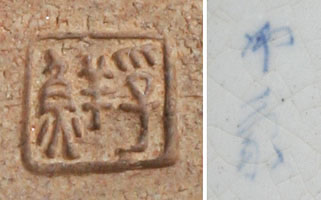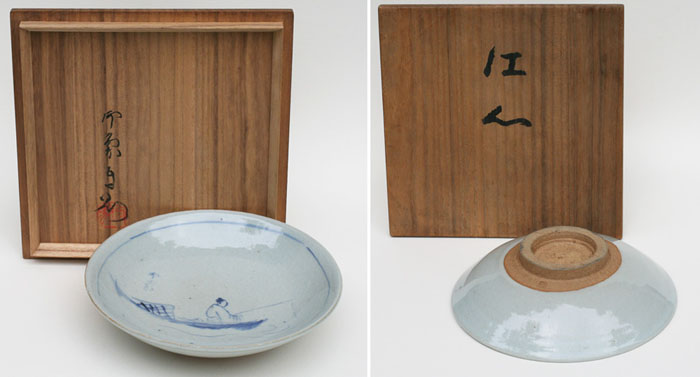Kyôyaki
Sara, plate - Kôshin, In the middle of the riverSigned: Inshô
Seals: Fuyôgyo
Technique: Fine crackeled kyôyaki, with an underglaze decoration Ø 20 x 5,6
Date: c. 1930
Box: signed
Condition: fine
The image of a fishing scholar is known as taikôbô, ‘the hope of the duke’. The duke in question was Lu Shang, a misunderstood strategist who had fled the world and spent his days fishing. Once his strategic talents were recognised he became an important figure at the Shang dynasty court. Taikôbô is now used as a general term for images of literati fishing.
Fukuda Heihachirô (1892-1974) and Inshô were considered Kyoto’s top Nihonga painters of their generation. Inshô was the more controversial of the two and moved to abstract painting later, being the first of the Nihonga artists to do so.
Inshō was born in Kyoto. He was educated as a designer and drew patterns for textiles. However, between 1918 and 1924 he also studied Nihonga painting at the Municipal College of Painting and as a pupil of Nishiyama Suishō (1879-1958).. After he had won a prize for a large Buddhist painting at the Teiten exhibition in 1925, he received commissions from several Buddhist temples. During his lifetime he executed some 600 of these temple commissions.
Inshô was equally at home in traditional Japanese styles and western abstract painting. In 1952 he went to Europe as one of the first Nihonga painters to travel abroad after the war. His abstract works shook Japan, but they favoured his career in the western world with exhibitions in Paris, Turin and New York. He designed and built his own Dōmoto Art Museum in Kyoto in 1966.
Reference:
Kyoto 1977
Roberts p. 19
Conant p. 291
Berry pp. 282-287 (# 80-81)
Goto # 153-154
Price: ON REQUEST

